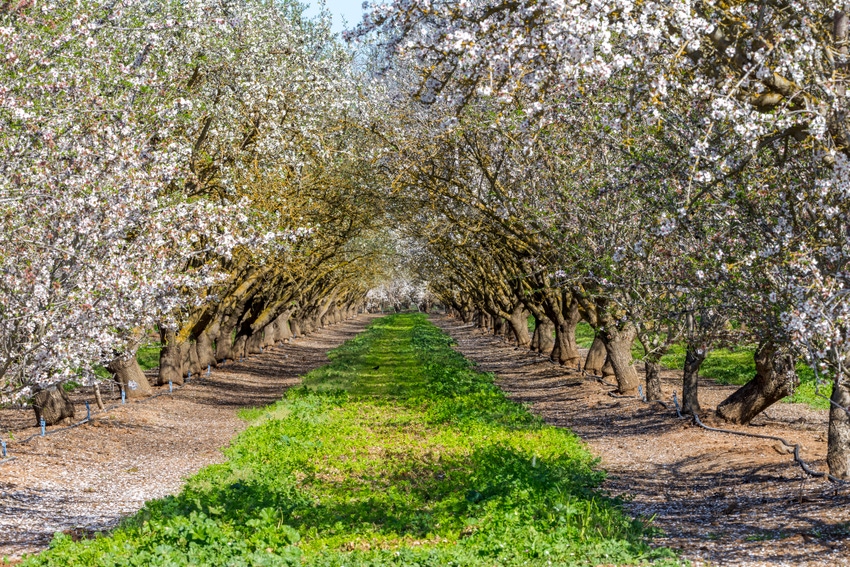
Now that we are on the downward slope to June and two-thirds of the way through the spring season, temperatures are beginning to heat up in California and other western states, including in tree nut orchards in the south and south-central region of the Golden State’s productive valleys, bringing both good news and not-so-good news for farmers.
Scouting efforts continue and have increased to keep pace with the season and many growers are occupied with troubling weeds, while others consider revising their irrigation plans in areas where soil and leaf moisture benefited greatly from abundant winter rain and a substantial snowpack.
Not all the news and updates are so good from a farmer’s perspective. A long time developing, the California Environmental Protection Agency has pulled the trigger on the use of chlorpyrifos within the state. Chlorpyrifos is used widely in California on more than 800,000 acres and across at least 60 crops including tree nuts, grapes, citrus, vegetables, cotton and alfalfa.
The ban won’t happen overnight. It could take up to two years to eliminate the inventory and use of chlorpyrifos according to analysts. Opponents to the move to ban the pesticide, including many farm groups, say the measure depletes the number of tools available for farmers to control insects and puts farmers at greater risk loss.
More bad news: Walnut growers in parts of the San Joaquin and Sacramento Valleys are reporting leaf out in the lower canopies of many walnut trees, both young and mature and across several varieties, while upper canopies remain largely bare in some blocks in a growing number of orchards. Some are calling it a mystery, with freezing temps at night and warm temps by day last November being the possible primary culprit. We offer more on the story today in a stand-alone article you can find in the Tree Nut Farm Press e-newsletter and on the Western Farm Press website.
In another developing story, we offer yet another new article, this one to explore the developing problems, underlying causes, and possible solutions to farm labor issues in California. Though mechanization efforts have advanced and provide some relief from labor-intense farming issues in recent months and years, a shortage of seasonal farm workers becomes more difficult for growers who depend upon it as Mexico is now reportedly competing domestically for its own workers.
Although more California farmers are using the federal H-2A agricultural visa program, it still makes up a small percentage of total agriculture operations that benefit with just under 6-percent of surveyed farmers saying they had enrolled in the H-2A program over the last five years. But possible Congressional legislation could be changing that soon.
You can catch up with the latest updates and new articles at the Western Farm Press Tree Nut index, an aggregation of news and issues specific to the tree nut industry and mostly focused on nut farming in California and the Western States region.
Speaking of farm labor problems and the need for more advancement in agriculture technology, can you imagine a robot with fingers so gentle it can pick ripe tomatoes successfully? The PEW Charitable Trusts explores the topic. And developers say if you think that’s a major advancement, just wait thirty years and see what robotics can do for farming. It could blow your mind - figuratively speaking (we hope)!
TRADE ISSUES – AGAIN
Also this week, news over the issue of U.S. trade deals with China, Europe and other trading partners is surfacing and potential roadblocks are indeed concerning. It’s not only the new tariffs imposed by the Trump administration but also in the issue of getting all three nation-partners to ratify the United States-Mexico-Canada Agreement, or NAFTA 2.0 as a few still call it. U.S. trade troubles could quickly escalate.
Yahoo Finance cites a Bloomberg report that suggests a new and long-lasting trade tariff increase on China potentially endangers if not threatens to devastate some U.S. farmers.
READY TO IRRIGATE?
Just a reminder, before you start irrigating the orchard, consider plant water stress (stem water potential measurements) and soil moisture sensor readings. Recent research in the Sacramento Valley has found irrigation can be delayed until June in some years.
Also, Sacramento Valley farm advisors recommend farmers should be certain to hang Walnut Husk Fly traps by June 1. Yellow sticky traps charged with an ammonium carbonate lure work best. Check traps 2 to 3 times per week and treat based on detection of eggs in trapped females, overall trap catch numbers, or the first flies caught depending on spray material used, husk fly population, and previous damage. For more details on treatment decisions, check it out here.
A FEW MEETINGS AND EVENTS TO NOTE
Nitrogen Management Plans Self-Certification Course
Westside San Joaquin River Watershed Coalition event
May 21, 2019, 8:30 am - 1:30 pm in Parlier, California
Register: call 916-798-8003 or email [email protected]
Second Annual Groundwater Sustainability Summit
June 5, 2019, 8:15 am – 4:30 pm
Radisson Hotel Fresno, California
Almond Board of California China Delegation Breakfast Meeting
For all handlers and industry members
May 21, 2019, 8:30 am-10:30 am
Almond Board of California Offices, Double Tree Hotel
1150 Ninth St, Suite 1500, Modesto, California
For more news on tree nuts as reported by growers and farm advisors, subscribe to the Tree Nut Farm Press e-newsletter.
About the Author(s)
You May Also Like






